JOBS TO BE DONE
a roadmap for customer centered innovation
6/27/20254 min read

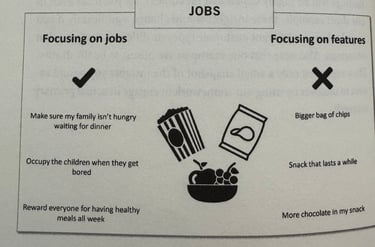
JOBS
Jobs are the tasks that consumers are trying to get done in their everyday lives.
Research needs to focus on uncovering consumers' jobs, not just what they're currently buying or what they think a good solution would look like.
Look to satisfy both functional emotional jobs.
While consumers will be looking to satisfy a number of jobs, some will be more important than others. Focus first on satisfying those ''North Star'' jobs.
In your research, keep asking ''why?'' to make sure you understand the true underlying jobs.
JOB DRIVERS
Job drivers are the underlying factors that make particular jobs more or less important for different types of consumers.
Job drivers can be uncovered by looking at three broad categories: attitudes, background, and circumstances.
Jobs and job drivers combine to yield customer segments-- group of customers who will buy and behave in similar ways.
Rather than building fully loaded, one-size-fits-none products, new offerings should be targeted to specific customer segments by focusing on the jobs that are important to those specific consumers.
CURRENT APPROACHES AND PAIN POINTS
The product purchaser is just one of several stakeholders who may need to be satisfied with your new offering. Consider whether there is an end user or other key decision maker who will need to be satisfied.
Current approaches are the range of activities that collectively represent a customer's way of doing something. Pain points--a breeding ground for innovation--are the areas of difficulty, frustration, or inefficiency along the way.
Because context can affect which jobs are in play, remember to ask about specific occasions (not just average behavior), getting as detailed as possible.
Consumers are often attached to their current approaches, so carefully consider how fast you can expect consumers to change their behavior if your solution requires such change.
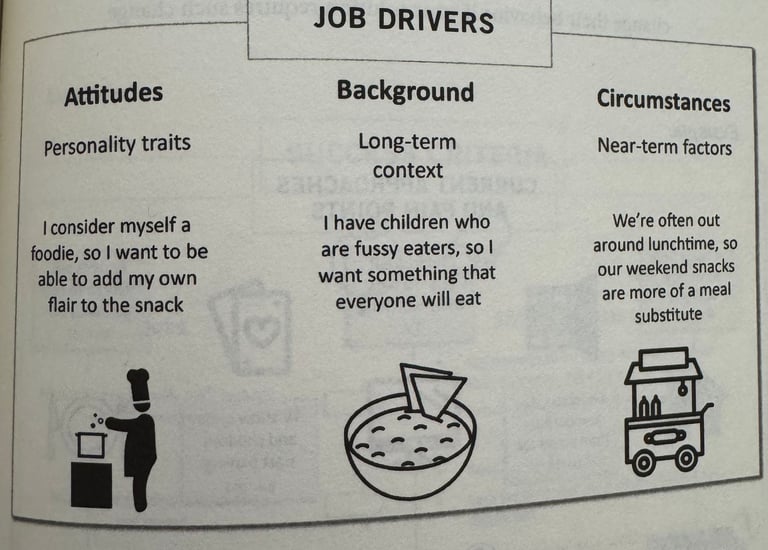

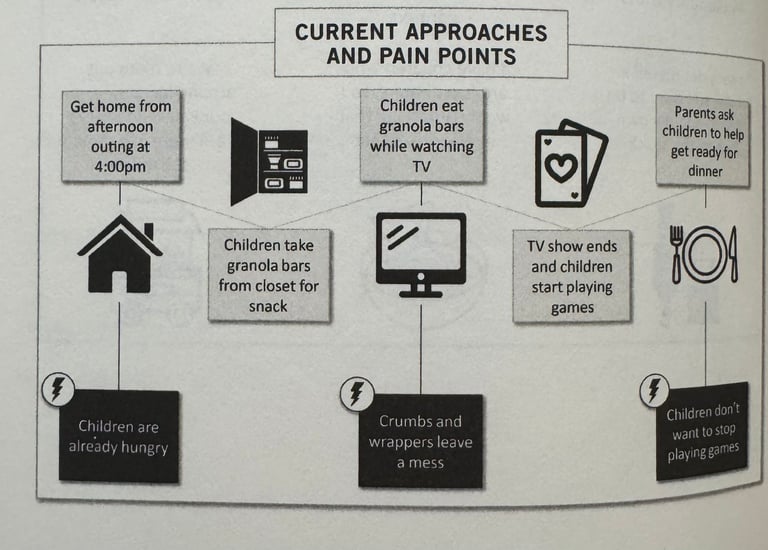

SUCCESS CRITERIA
Success criteria are not just jobs but rather indications of whether a job has been satisfied.
The success of new product will often require homing in on particular occasions and contexts that are the most important to the customer.
To get started, try understanding what customers want more of, what they want less of, and where they are seeking balance.
Your new solution may ultimately require making trade-offs. It's perfectly acceptable to give up on features that matter to a limited number of customers as long as you excel along the dimensions that matter most to your targeted customer segments.
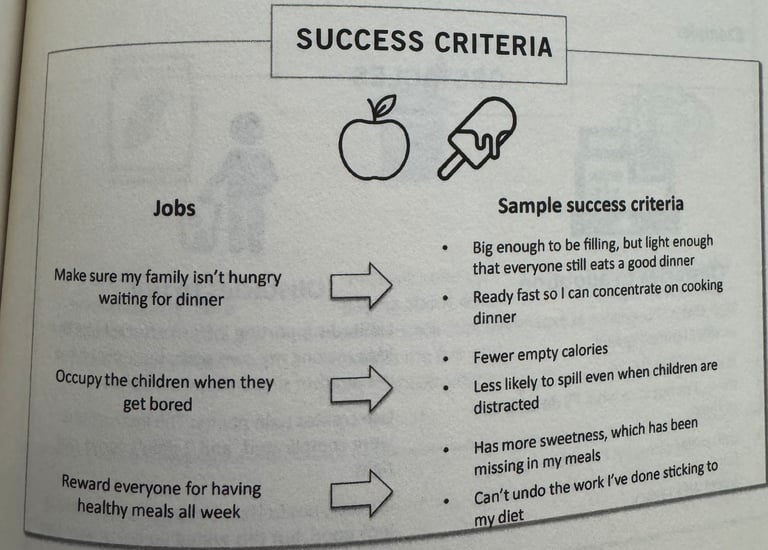

OBSTACLES
Obstacles come in two forms: obstacles to adoption and obstacles to use.
Obstacles to adoption are hurdles that limit a consumer's willingness to buy an offering.
Obstacles to adoption can be reduced by making it easy for people to learn about and try your new offering.
Obstacles to use are hurdles that get in the way of success, thereby limiting a customer's likelihood of continuing to use a product, purchasing add-ons, or upgrading to newer versions.
Continuously acquiring a new customer base is often too costly to be sustainable, making it important to eliminate obstackes to use so that first time buyers become repeat buyers.

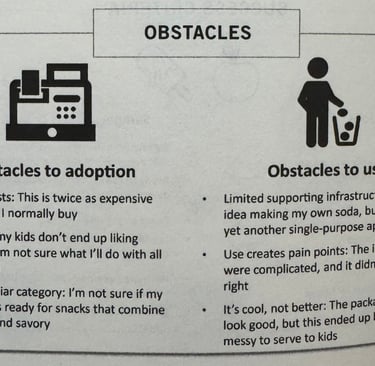
VALUE
Understanding how much money is at stake with respect to a new solution requires framing markets in terms of jobs, not products.
A value-based pricing strategy that accounts for the unique or emotional jobs your offering satisfies can help you more accurately understand how expensive your solution can and should be.
In addition to thinking about the value you're offering the customer and other key stakeholders, your solution needs to bring in value for the organization.
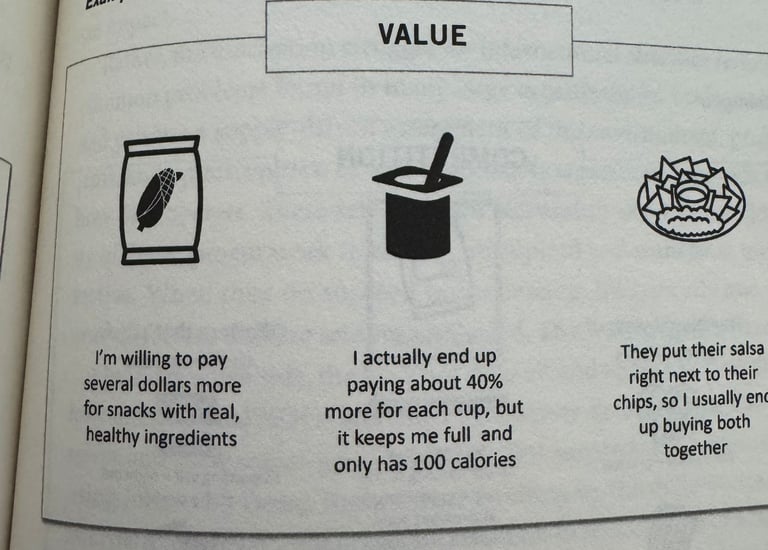

Here below the additional notes I took:
Only 1 in 300 new products has a significant impact on customer purchase behavior, the product category, or the company's growth trajectory.
***** Breakthroughs come from reimagining problems, not from creating an incrementally better solution to a well understood challenge.
Parents may choose to bring their children to a movie on a Saturday afternoon, but the underlying job is to keep the kids entertained.
People don't want to buy a quarter inch drill. They want a quarter inch hole.
Knowing that high-spending card-holders were between ages of 35 and 50 and had large incomes was nice, but knowing that the reason some spend so much was because they travel on business at least once per month yielded a trove of opportunities for the company.
Pain points are problems that inhibit a customer's ability to get a job done.
Every pain points creates room for innovation.
I honestly didn’t enjoy this book very much. It was overloaded with abstract theory, reminiscent of a low-tier college textbook. That said, I’ve included all the relevant information above to underscore the importance of the ‘Jobs to Be Done’ concept.
